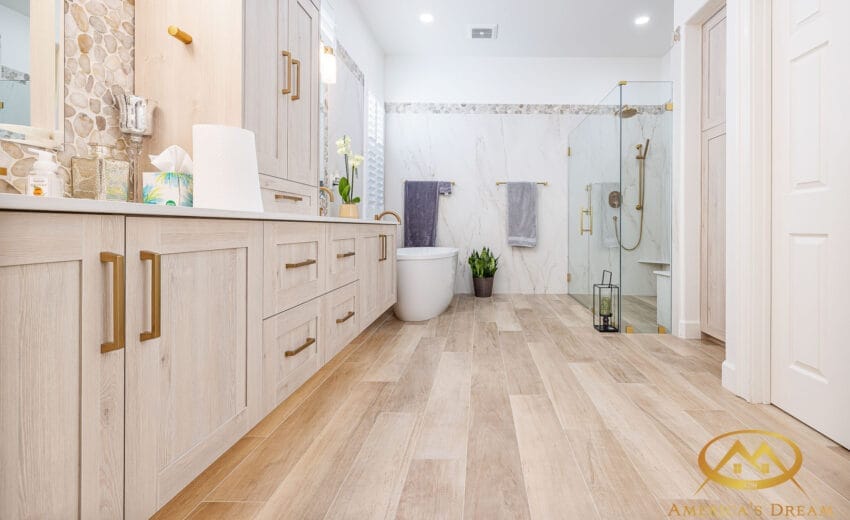In recent years, the interior design and home remodeling industry has seen a rise in gray wood flooring popularity! Gray is a versatile color that comes in both cool tones and warm hues allowing it to pair well with many different tastes and styles in design. Compared to traditional light and dark wood floors, gray wood provides a balance between warmth and coolness, making it an appealing choice.
What is Gray Wood Flooring?
Gray wood flooring is a type of flooring made from natural wood material, stained with a gray coating which can range from light silvery tones to deep charcoal hues. The color shade is typically achieved by natural aging, special treatments, and staining. This process enhances the wood’s natural grain while giving it a contemporary and modern look.
There are different types of gray wood finishes, including:
- Natural Gray: A subtle, understated hue that maintains the wood’s natural beauty with a soft, grayish tint.
- Weathered Gray: Often created by exposure to sunlight or by using weathered wood, this finish has a rustic, aged appearance, perfect for farmhouse or coastal styles.
- Cool-Toned Gray: A sleek, modern shade with bluish or greenish undertones, ideal for urban and industrial designs.
Gray wood flooring falls into the neutral palette, which keeps it a versatile option for different design styles. It is often used to enhance modern, contemporary, and industrial designs—where its subtle elegance highlights minimalist decorations and complements a wide range of interior elements.
Gray Wood Flooring vs. Light Wood Flooring
Light wood flooring usually includes wood species like oak, ash, or maple and is typically finished in pale, golden, or beige tones. These light shades create a warm, inviting atmosphere, enhancing natural light and making spaces feel open and airy. Light wood floors are often associated with traditional designs, but they can also fit into more modern and coastal styles due to their bright, neutral aesthetic.
When comparing gray wood flooring to light wood, the differences are clear. While light wood flooring offers brightness and warmth, gray wood flooring offers more muted tones that give a sophisticated, contemporary vibe. Gray wood’s neutrality enhances subtleness and provides a calm, serene atmosphere, which allows for bolder design elements or vibrant colors in furniture and décor.
Gray Wood Flooring vs. Dark Wood Flooring
Dark wood flooring is characterized by rich, deep hues like those found in walnut, cherry, and mahogany. These woods bring a sense of luxury, sophistication, and boldness to a space. Dark wood floors are known for their elegance and timeless appeal, often used in traditional, rustic, or high-end interior designs.
When compared to gray wood flooring, dark wood tends to evoke a more classic feel, while gray wood introduces a more modern aesthetic. Dark wood creates a luxurious and grand atmosphere, often serving as a focal point in traditional or vintage-inspired settings.
A Bold Twist on Traditional Flooring: Colored and Black Wooden Floors
Colored and black wooden floors represent a striking departure from traditional wood finishes, offering a bold twist on classic hardwood styles. Colored wood flooring can include hues like blue, green, red, and even pastel shades and allows homeowners to express their creativity and design a unique space.
On the other hand, black wooden floors are the definition of sophistication and drama. The deep, dark hue creates an air of elegance and refinement, making them an excellent choice for luxurious interiors or rooms that require a strong, defining design. Black wood floors are perfect for creating high-contrast designs, where they can serve as a dramatic backdrop for light-colored furniture, bright artwork, or metallic accents.
Check Our Recent Projects
The Best of Both Worlds: Gray Vinyl Flooring
If you’re sold on the gray color scheme for flooring but unsure about the material choice of wood, here’s the solution you’ve likely been searching for: gray vinyl flooring.
Gray vinyl flooring has grown as a popular alternative to gray wood flooring. Gray vinyl flooring has all the same neutral color palette benefits of gray wood flooring that allow for a versatile foundation for any style of space and offers a number of practical advantages. One of the most significant is cost-effectiveness! Vinyl flooring is generally far more affordable than hardwood, making it an attractive option for those wanting to update their space within a budget.
Additionally, vinyl’s durability is a huge selling point and makes gray vinyl flooring an excellent choice for high-traffic areas, bathrooms, and even basements, where wood flooring may not be as practical.
Conclusion
Overall, gray flooring—whether wood or vinyl—remains a timeless, versatile, and stylish choice for homeowners and interior designers. Its neutral color palette suits a variety of styles and creates a serene and modern atmosphere.

















